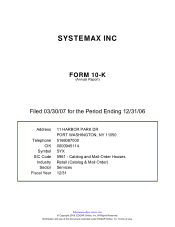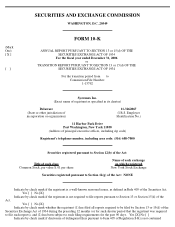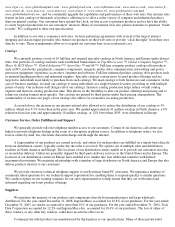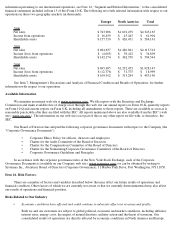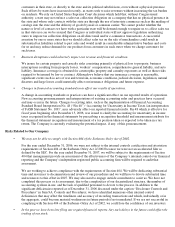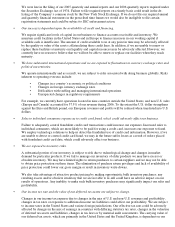Circuit City 2006 Annual Report Download - page 9
Download and view the complete annual report
Please find page 9 of the 2006 Circuit City annual report below. You can navigate through the pages in the report by either clicking on the pages listed below, or by using the keyword search tool below to find specific information within the annual report.
We may experience a decline in sales as a result of poor economic conditions and the lack of visibility relating to
future orders. Our results of operations depend upon, among other things, our ability to maintain and increase
sales volumes with existing customers, our ability to attract new customers and the financial condition of our
customers. A decline in the economy that adversely affects our customers, causing them to limit or defer their
spending, would likely adversely affect us as well. We cannot predict with any certainty whether we will be able
to maintain or improve upon historical sales volumes with existing customers, or whether we will be able to
attract new customers.
In response to economic and market conditions, from time to time we have undertaken initiatives to reduce our
cost structure where appropriate. The initiatives already implemented as well as any future workforce and
facilities reductions undertaken may not be sufficient to meet the changes in economic and market conditions and
to achieve future profitability. In addition, costs actually incurred in connection with our restructuring actions
may be higher than our estimates of such costs and/or may not lead to the anticipated cost savings.
•
Increased costs associated with corporate governance compliance may impact our results of operations.
As a public company, we incur significant legal, accounting and other expenses that we would not incur as a
private company. In addition, the Sarbanes-Oxley Act of 2002, as well as rules subsequently implemented by the
Securities and Exchange Commission and listing requirements subsequently adopted by the New York Stock
Exchange in response to Sarbanes-Oxley, have required changes in corporate governance practices of public
companies. These developments have already substantially increased our legal compliance, auditing and
financial reporting costs and made them more time consuming. We anticipate that the Company will be subject
to the requirements of Section 404 of the Sarbanes-Oxley Act as of December 31, 2007, and that costs will
further increase and make some compliance activities more time consuming. These developments may make it
more difficult and more expensive for us to obtain directors’ and officers’ liability insurance and we may be
required to accept reduced coverage or incur substantially higher costs to obtain coverage, possibly making it
more difficult for us to attract and retain qualified members of our board of directors, particularly to serve on our
audit committee. We presently cannot estimate the timing or magnitude of additional costs we may incur as a
result of the implementation of Section 404 of the Sarbanes-Oxley Act; however, to the extent these costs are
significant, our general and administrative expenses are likely to increase as a percentage of revenue and our
results of operations will be negatively impacted.
•
Competitive pressures could harm our revenue and gross margin.
We may not be able to compete effectively with current or future competitors. The markets for our products and
services are intensely competitive and subject to constant technological change. We expect this competition to
further intensify in the future. Competitive factors include price, availability, service and support. We compete
with a wide variety of other resellers and retailers, as well as manufacturers. Some of our competitors are larger
companies with greater financial, marketing and product development resources than ours. In addition, new
competitors may enter our markets. This may place us at a disadvantage in responding to competitors’ pricing
strategies, technological advances and other initiatives, resulting in our inability to increase our revenues or
maintain our gross margins in the future.
In many cases our products compete directly with those offered by other manufacturers and distributors. If any of
our competitors were to develop products or services that are more cost-
effective or technically superior, demand
for our product offerings could decrease.
Our gross margins are also dependent on the mix of products we sell and could be adversely affected by a
continuation of our customers’ shift to lower-priced products. As do most other companies in the technology
products industry, we advertise manufacturers’ mail-in rebates on many products we sell and, in some cases,
offer our own rebates. We process these rebates through third party vendors and in house. If we are unable to
fulfill these rebates in a timely and satisfactory manner, our reputation in the marketplace could be negatively
impacted.
•
State and local sales tax collection may affect demand for our products.
Our United States subsidiaries collect and remit sales tax in states in which the subsidiaries have physical
presence or in which we believe nexus exists which obligates us to collect sales tax. Other states may, from time
to time, claim that we have state-related activities constituting a sufficient nexus to require such collection.
Additionally, many other states seek to impose sales tax collection obligations on companies that sell goods to

